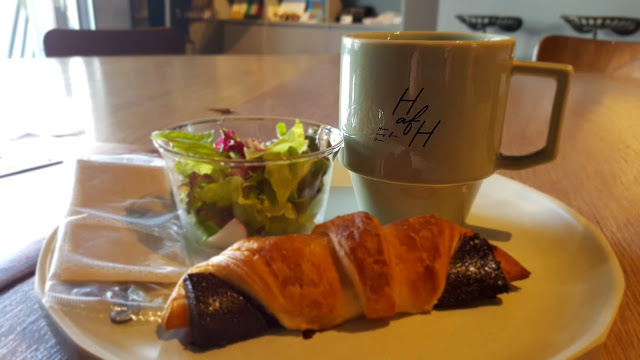 |
| Bright and sunny the next day |
I had ideas of champon lunch, snacks of kasutera, pre-dinner of sasebo burger and then dinner of saraudon. Plans of tramming to Peace Park and strolled my way to Oura Church area.
Ahem. Didn't really happen. Didn't even make it to the Peace Park even though I went to Nagasaki Atomic Bomb Museum as it was still raining quite heavily.
Nagasaki Atomic Bomb Museum
Getting here by streetcar: Atomic Bomb Museum stop (20) on line 1 (blue) or 3 (red). It's about 5 minutes walk from there. There are signs around to indicate which direction to head to.
Entrance fee: ¥200
A uranium atomic bomb exploded over Hiroshima on 6th August 1945 at 8:15am.
3 days later on 9th August 1945, Bockscar (name of the US Army Air Forces B-29 bomber) left Tinian Island carrying the Fat Man nuclear weapon. The bomber circled over Kokura three times but changed course for Nagasaki due to smoke cover. Visibility was also poor over Nagasaki and the crew considered to return to base due to dwindling fuel. The clouds broke and a plutonium atomic bomb was released over the city at 11:02am.
This is Fat Man, the atomic bomb that was dropped on Nagasaki. It was given the nickname "Fat Man" because of its shape, length 3.25m, diameter 1.52m and weight of 4.5t. It had a plutonium core with explosive force equivalent to 21kt of TNT.
The museum covers the history of the event, events leading to the day, consequences after and reconstruction of Nagasaki.
Nagasaki Shinchi Chinatown
Getting here by streetcar: Shinchi Chinatown stop (31) on line 1 (blue) or 5 (green).
Entrance fee: Nil
Nagasaki Shinchi Chinatown (長崎新地中華街, Nagasaki Shinchi Chūkagai) is the oldest Chinatown in Japan. It is the quietest of any Chinatown I've been.
 |
| Quiet - like this! |
Dejima (出島)
Getting here by streetcar: Dejima stop (30) on Line 1 (blue)
Entrance fee: ¥510 (I didn't pay to enter)
Dejima or literally translated as "exit island" was an artificial island built to house Portuguese residents to segregrate them from Japanese population in the Edo Period. After the Portuguese were expelled from Japan, the Dutch moved in.
Dejima is no longer an island currently but the historical structures remained. Prior to arriving in Nagasaki, I didn't realised it was a closed area and required admission fee to enter. I didn't end up going in but the the Southern Embankment Wall area can be seen from outside.
Dutch Slope or Hollander Slope (オランダ坂, Oranda-zaka)
Getting here by streetcar: Short walk from Medical Center stop (47) on Line 5 (green)
Entrance fee: Nil
In the past, non Asians were referred as Dutch by the people in Nagasaki because majority of foreigners were Dutch sailors living on Dejima. This slope was so named as it was often bustling with westerners.
Higashiyamate Western-Style House(東山手洋風住宅群)
Getting here by streetcar: 4 minutes walk from Ishibashi Stop (51) on Line 5 (Green)
These are 7 western style houses constructed mid 19th century, originally to rent to foreigners. Currently it houses preservation centre, museum, etc. It was already dark by the time I got there, so everything was closed.
View from Glover Garden (グラバー園, Glover-en)
Getting here by streetcar: 5 minutes walk from Ouratenshudo-Shita Stop (51) on Line 5 (Green)
Entrance fee: ¥610 for the garden but closed by the time of my visit. View is free :)
Thomas Glover was a Scottish trader who went to Nagasaki when Japan started to open up to the outside world. He supplied weapons to anti-shogun clans and overthrew the world's longest continuous dictatorship and ushered in Meiji restoration. Glover was remembered as one of the key influence to modern Japan. He helped in finding the shipbuilding company which later became Mitsubishi Corporation of Japan and also helped to establish the Japan Brewery Company which is now Kirin Brewery Company. Glover Garden was built in honour of this Scottish merchant.
I went up to the garden via Glover Garden Elevator.
Oura Church (大浦天主堂, Ōura Tenshudō)
Getting here by streetcar: 4 minutes walk from Ouratenshudo-Shita Stop (51) on Line 5 (Green)
Entrance fee: ¥1000
The Oura Catholic Church was constructed by 2 French priests in 1964. I read that the stained glass windows and the statue of the Virgin Mary were imported from France too. It is Japan's oldest wooden Gothic style church.
 |
| Photo taken from outside the gate... |
Meganebashi or Spectacles Bridge (眼鏡橋)
Named so from it's resemblance to a pair of spectacles when reflected on the river water. The bridge was originally built in 1634, but repaied with recovered stones in 1982.
I didn't end up eating most of the food that I wanted to try but I did have champon, just not at where I initially go. I went in a random shop in Chinatown. This is the mini version, ¥500. Popular restaurants to have this dish were Shikairō (四海楼) and Horaiken Bekkan.
I also wanted to try kasutera from Shōkandō under the recommendations of my friends from Japanese lessons in the past. They are foodies and travel to Japan annually! I missed the opening hours of Shōkandō and unfortunately I don't think they have other branches except the one shop near Meganebashi. I did however, bought 3 boxes (2 plain, 1 matcha) from Bunmeido from one of their branch in Fukuoka before I travelled out of Kyushu.
There are definitely more things to explore, see and eat in Nagasaki which I missed :( Well, guess I'll have to go back again. :)
P/S: I walked from Chinatown to Oura Church.
Side note: Detective Conan episode 678-679

























